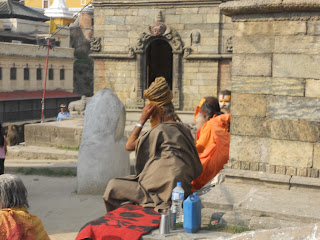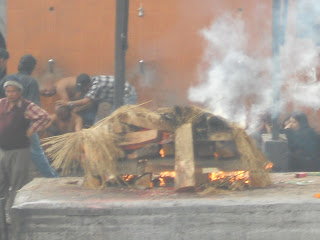Before I discuss Bina and the school, though, I want to mention our afternoon visit to Pashupatinath, the most sacred Hindu temple in Kathmandu (probably in all of Nepal). Unfortunately, non-Hindus are not allowed to enter the temple itself, but there is plenty to see and experience around the grounds. There are Sadhus (religious ascetics), adorned in outlandish garb and decorated with colorful paint. Some of these are sincere spiritual seekers, but many of them are more interested in earning an extra buck posing for tourist photos. Regardless, they add to the out-of-this-world vibe that Pashupatinath emits. In addition to the Sadhus, there are laypersons around enjoying their afternoons and worshipping at any of the many Hindu shrines that dot the complex.
 |
| Sadhus sitting around the temple grounds. |
 |
| Meditating Sadhu. |
 |
| Resting Sadhus. |
On one side of the river, there are about 5 cement platforms jutting out over the shallow, polluted river. Throughout the course of an hour or so, we saw 4 cremations in progress. When a funeral occurs, a pyre is constructed using big logs. Then, the lifeless body, wrapped in cloth, is laid upon the pyre and covered with dry straw. After that, with a crowd of family and friends around, the bottom of the logs are set ablaze. Smoke billows out from the stack, and the people look at it sullenly until they all eventually trickle away. After a little while, the pyre is reduced to a smoldering campfire containing ashen human remains, which are then swept into the Bagmati River.
I am not going to pretend that I had some life-altering revalation while witnessing the cremations. However, watching the funerals from the opposite side of the river, I could not help but feel a sense of somber appreciation. I have always liked the idea of cremation--ashes to ashes, dust to dust, et cetera, et cetera. There is something wonderful about the way in which cremation expedites this process of returning us to unconcious matter. Eventually, it happens to everyone. At the risk of sounding crass, we all ultimately become worm food and fertilizer. Regardless of one's religious (or non-religious) opinion about an eternal soul, nobody can deny this fact about the physical body. For this reason, I have never fully understood things like embalming fluids and lacquered caskets. Perhaps this is why I found the Hindu cremation rites so moving--no frills, no illusions. In the burning funeral pyres, there exists an inherent acceptance of one's body returning to a state of ash and dust, so to speak. I could ramble about this forever, and that's a blog entry for another day. In any event, it was a really beautiful thing to see.
 |
| Pre-cremation funeral pyre all prepared. |
 |
| Early in the blaze. |
 |
| Cremation with the Bagmati River below. |
 |
| Play time at the school. |
 |
| The recently built addition. |
At the end of the day, the organization is about the kids. When I first visited here, the small school was just a drop-off place for children with no place else to go. While it still serves that important social purpose today, it has also transformed into a fully functional daycare and early education center. It's truly amazing what Bina has done. Having returned, I can see the difference she has made in the lives of specific children. Bina packs pounds onto undernourished children. She patiently helps students spell words in English. She has an almost unbelievable rapport with the younger children (ages 0-3), who respect her and love her dearly. Bina has a real passion for helping children, and in doing so she purposefully helps their parents escape the shackles of poverty. The plan is perfect in its simplicity, and it works. It is impossible not to be touched by the positive effects of Bina's efforts. I have never seen such adorable, happy children from such strained backgrounds:
 |
| A bi-weekly music class that Bina has arranged with a local musician. |
The school depends on outside support, and it is a registered non-profit. If you would like to donate, please let me know. I can assure you that your money will be allocated honestly and wisely on food, scholarships (to help the children go to private schools when they come of age), books, and equipment. I can send literature to anyone who requests it. If you happen to have a slightly heavy wallet and a desire to help an organization that makes a real, measurable difference, this is a great way to do that. Bina has learned to stretch donations as far as they will go, so anything and everything helps a great deal. Let me know. (Sorry for the Public Service Announcement. I got carried away, but it is a very worthy cause if you're in the market.)
That's all for now. Barring any weather-related problems, Mike and I will be doing some extended trekking starting next week, which I'm very excited about. It's supposed to be some of the most beautiful scenery in the Himalayas, so hopefully the weather will permit us to go. Until then, I look forward to hearing from all of you.
"Be well, do good work, and keep in touch."
.









Hey Ben its Jordan (sas) i love the blog man great pics and even better stories, like always : ). have fun and be safe my friend
ReplyDelete